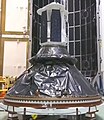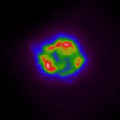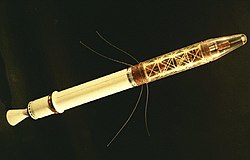Imaging X-ray Polarimetry Explorer
| Imaging X-ray Polarimetry Explorer | |
|---|---|
 | |
| IXPE-Satellit, oben sind seine drei identischen Röntgenoptikelemente, unten die Sensoren | |
| Typ: | Weltraumteleskop |
| Land: | |
| Betreiber: | |
| COSPAR-ID: | 2021-121A |
| Missionsdaten | |
| Masse: | 330 kg |
| Start: | 9. Dezember 2021, 06:00 UTC |
| Startplatz: | Kennedy Space Center, LC-39A |
| Trägerrakete: | Falcon 9 Block 5 |
| Status: | im Orbit, aktiv |
| Bahndaten | |
| Umlaufzeit: | 90 min |
| Bahnneigung: | 0,20° |
| Apogäumshöhe: | 540 km |
| Perigäumshöhe: | 540 km |
Der Imaging X-ray Polarimetry Explorer (IXPE), auch als Explorer 97 oder SMEX 14 bekannt, ist ein Weltraumteleskop, das in Zusammenarbeit von Agenzia Spaziale Italiana und NASA konstruiert wurde. Es besteht aus drei Teleskopen, welche die Polarisation der kosmischen Röntgenstrahlung messen sollen.[1]
Die Hauptziele der Mission werden aktive galaktische Kerne, Mikroquasare, Pulsare, Pulsarwind-Nebel, Magnetare, Röntgendoppelsterne, Supernova-Überreste und das galaktische Zentrum sein.[2]
Mission
Der IXPE soll neue Informationen zur Geometrie und die physikalischen Prozesse bei der Strahlungsemission und Beschleunigung von Partikeln in Umgebungen mit extremen Magnetfeldern und Gravitationsfeldern liefern.
Der Start erfolgte am 9. Dezember 2021 vom Kennedy Space Center an Bord einer Falcon-9-Rakete in einen Low-Earth-Orbit.[3]
Galerie
- Aufbau des Teleskops
- Vor dem Start
- IXPE wird in die Nutzlastverkleidung integriert
- Die Falcon-9-Rakete auf der Startrampe
- Start der Falcon-9-Rakete mit IXPE
- IXPE löst sich von der Raketenoberstufe
- Aufnahme der Überreste der Supernova Cassiopeia A
Weblinks
- Beitrag des MDR vor dem Start (abgerufen am 10. September 2022)
- Informationen zu den ersten Beobachtungen von astropage.eu (16. Februar 2022, abgerufen am 10. September 2022)
Einzelnachweise
- ↑ IXPE: Home. Abgerufen am 5. September 2022.
- ↑ Karen Northon: NASA Selects Mission to Study Black Holes, Cosmic X-ray Mysteries. 3. Januar 2017, abgerufen am 5. September 2022.
- ↑ Steven R. Ehlert, Riccardo Ferrazzoli, Andrea Marinucci, Herman L. Marshall, Riccardo Middei: Limits on X-Ray Polarization at the Core of Centaurus A as Observed with the Imaging X-Ray Polarimetry Explorer. In: The Astrophysical Journal. Band 935, Nr. 2, 1. August 2022, ISSN 0004-637X, S. 116, doi:10.3847/1538-4357/ac8056 (iop.org [abgerufen am 5. September 2022]).
Auf dieser Seite verwendete Medien
Explorer 1 satellite
IXPE deployment a nd solar arrays unfurling
Logo Agenzia Spaziale Italiana
NASA’s newest X-ray astronomy mission, Imaging X-Ray Polarimetry Explorer (IXPE), is scheduled to launch Dec. 9, 2021. IXPE will launch aboard a SpaceX Falcon 9 vehicle from Kennedy Space Center’s Launch Complex 39A in Florida. The launch is managed by NASA’s Launch Services Program, based at Kennedy.
IXPE will study changes in the polarization of X-ray light through some of the universe’s most extreme sources, including black holes, dead stars known as pulsars, and more. Polarization contains clues to what those environments are like and helps scientists better understand these mysterious phenomena.
IXPE is NASA’s first mission dedicated to measuring X-ray polarization.
NASA selected IXPE as a Small Explorer mission in 2017. The IXPE project is a collaboration between NASA and the Italian Space Agency. NASA’s Marshall Space Flight Center in Huntsville, Alabama manages the IXPE mission. Ball Aerospace, headquartered in Broomfield, Colorado, manages spacecraft operations with support from the University of Colorado at Boulder.
NASA’s Goddard Space Flight Center in Greenbelt, Maryland, manages the Explorers Program for the agency’s Science Mission Directorate in Washington.Prelaunch images of IXPE satellite
NASA’s Imaging X-Ray Polarimetry Explorer (IXPE) spacecraft and nose fairing are brought together for encapsulation inside SpaceX’s Payload Processing Facility at Kennedy Space Center in Florida on Dec. 2, 2021. The mission is scheduled to launch no earlier than Thursday, Dec. 9, at 1 a.m. EST, on aSpaceX Falcon 9 rocket from Launch Complex 39A at NASA’s Kennedy Space Center in Florida. IXPE is the first satellite dedicated to measuring the polarization of X-rays from a variety of cosmic sources, such as black holes and neutron stars.
A SpaceX Falcon 9 rocket launches with NASA’s Imaging X-ray Polarimetry Explorer (IXPE) spacecraft onboard from Launch Complex 39A, Thursday, Dec. 9, 2021, at NASA’s Kennedy Space Center in Florida. The IXPE spacecraft is the first satellite dedicated to measuring the polarization of X-rays from a variety of cosmic sources, such as blackholes and neutron stars. Launch occurred at 1:00 a.m. EST. Photo Credit: (NASA/Joel Kowsky)
Vue d'artiste du télescope spatial de la NASA IXPE (légendes en anglais)
A SpaceX Falcon 9 rocket carrying NASA’s Imaging X-ray Polarimetry Explorer (IXPE) spacecraft is seen on the launch pad at Launch Complex 39A, Wednesday, Dec. 8, 2021, at NASA’s Kennedy Space Center in Florida. The IXPE spacecraft is the first satellite dedicated to measuring the polarization of X-rays from a variety of cosmic sources, such as black holes and neutron stars. Photo Credit: (NASA/Joel Kowsky)
This image from NASA’s Imaging X-ray Polarimetry Explorer maps the intensity of X-rays coming from the observatory’s first target, the supernova Cassiopeia A. Colors ranging from cool purple and blue to red and hot white correspond with the increasing brightness of the X-rays. The image was created using X-ray data collected by IXPE between Jan. 11-18.
NASA’s IXPE Sends First Science Image In time for Valentine’s Day, NASA’s Imaging X-Ray Polarimetry Explorer which launched Dec. 9, 2021, has delivered its first imaging data since completing its month-long commissioning phase.
All instruments are functioning well aboard the observatory, which is on a quest to study some of the most mysterious and extreme objects in the universe.
IXPE first focused its X-ray eyes on Cassiopeia A, an object consisting of the remains of a star that exploded in the 17th century. The shock waves from the explosion have swept up surrounding gas, heating it to high temperatures and accelerating cosmic ray particles to make a cloud that glows in X-ray light. Other telescopes have studied Cassiopeia A before, but IXPE will allow researchers to examine it in a new way.In the image above, the saturation of the magenta color corresponds to the intensity of X-ray light observed by IXPE. It overlays high energy X-ray data, shown in blue, from NASA’s Chandra X-Ray Observatory. Chandra and IXPE, with different kinds of detectors, capture different levels of angular resolution, or sharpness. An additional version of this image is available showing only IXPE data. These images contain IXPE data collected from Jan. 11 to 18.
After Chandra launched in 1999, its first image was also of Cassiopeia A. Chandra’s X-ray imagery revealed, for the first time, that there is a compact object in the center of the supernova remnant, which may be a black hole or neutron star.“The IXPE image of Cassiopeia A is as historic as the Chandra image of the same supernova remnant,” said Martin C. Weisskopf, the IXPE principal investigator based at NASA’s Marshall Space Flight Center in Huntsville, Alabama. “It demonstrates IXPE’s potential to gain new, never-before-seen information about Cassiopeia A, which is under analysis right now.”
A key measurement that scientists will make with IXPE is called polarization, a way of looking at how X-ray light is oriented as it travels through space. The polarization of light contains clues to the environment where the light originated. IXPE’s instruments also measure the energy, the time of arrival, and the position in the sky of the X-rays from cosmic sources.
“The IXPE image of Cassiopeia A is bellissima, and we look forward to analyzing the polarimetry data to learn even more about this supernova remnant,” said Paolo Soffitta, the Italian principal investigator for IXPE at the National Institute of Astrophysics (INAF) in Rome.
With polarization data from Cassiopeia A, IXPE will allow scientists to see, for the first time, how the amount of polarization varies across the supernova remnant, which is about 10 light-years in diameter. Researchers are currently working with the data to create the first-ever X-ray polarization map of the object. This will reveal new clues about how X-rays are produced at Cassiopeia A.
“IXPE's future polarization images should unveil the mechanisms at the heart of this famous cosmic accelerator,” said Roger Romani, an IXPE co-investigator at Stanford University. “To fill in some of those details, we’ve developed a way to make IXPE’s measurements even more precise using machine learning techniques. We’re looking forward to what we’ll find as we analyze all the data.”
IXPE launched on a Falcon 9 rocket from Cape Canaveral, and now orbits 370 miles (600 kilometers) above Earth’s equator. The mission is a collaboration between NASA and the Italian Space Agency with partners and science collaborators in 12 countries. Ball Aerospace, headquartered in Broomfield, Colorado, manages spacecraft operations.
https://www.nasa.gov/mission_pages/ixpe/index.html
Elizabeth Landau NASA Headquarters elizabeth.r.landau@nasa.gov 202-358-0845
Molly Porter NASA's Marshall Space Flight Center molly.a.porter@nasa.gov
256-424-5158



















